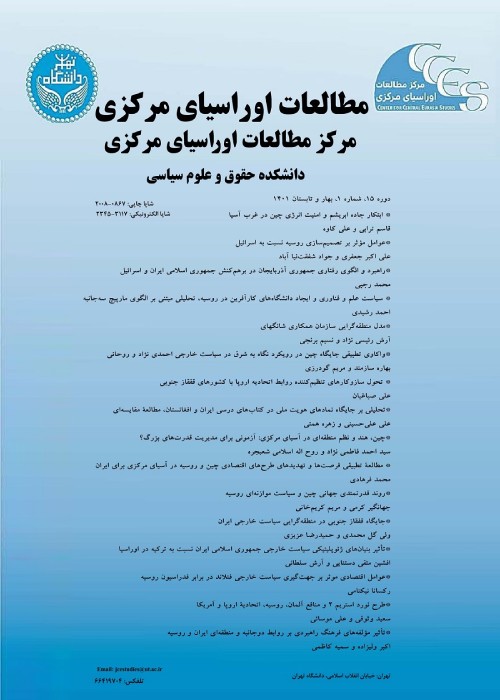The Place of Central Asia in India's New Foreign Policy: Implications for Iran
The end of the Cold War had a great impact on world politics. The destruction of the bipolar system and the emergence of a new international order affected the foreign policy of all countries in the world. On the other hand, after the collapse of the Soviet Union, a new region called Central Asia emerged, and small and large regional and trans-regional powers defined and redefined their relations with it due to its strategic importance. In this regard, India also made significant changes in its regional and international policies and took a new approach. Central Asia, which is near to the sub-continent, has long had close cultural, social and economic ties with India and renewing old agreements with this region is very important for this country. India's need to secure new energy sources for economic growth and development and access to new markets has made Central Asia an attractive and strategically important region for India. Also, with the spread of religious extremism and terrorism in the region, India is concerned about its spread within its borders. Consequently, India has many reasons to pursue its interests in the region. On the other hand, due to Iran’s geopolitical and geostrategic capabilities and its position in the North-South international transportation corridor and other international routes, this opportunity is available for our country to benefit from the advantages of partnership through economic cooperation with India, especially in the Chabahar project.
Research question:
This research tries to answer the basic question, what is the situation of Central Asia in India's new foreign policy and what opportunities does India's relationship with the region bring to Iran?Research hypothesis: Central Asia has a strategic position for India due to its geopolitical location and rich hydrocarbon and energy resources, market and access to Europe, and India’s access to Central Asia through Iran provides the common and individual interests for both sides.
Methodology and theoretical framework:
This research analyzes the subject by using the qualitative method and sample and process research method using the theory of Neo-liberalism. We will show that the developments of the international system after the Cold War, and the change in the strategic goals of India's foreign policy since the 90s, provides new opportunities for Central Asian countries and India for strategic- economic cooperation in which Iran can also play an important role.
Today, the geo-strategic prominence of Central Asia is emphasized by two main factors. First, Central Asia has gained importance due to the discovery of hydrogen resources and second, the region is a major transportation hub for gas and oil pipelines and multifaceted communication corridors connecting China, Russia, Europe, the Caucasus, the Trans-Caspian region and the Indian Ocean. India pursues numerous interests in Central Asia, but due to the lack of borders with the region and neighboring Afghanistan, India has to explore another way to connect with central Asia. “Connecting to Central Asia” policy focuses on broader aspects of India's cooperation with Central Asia in various issues such as strengthening bilateral and multilateral political relations, achieving strategic and security cooperation through military training, cooperation to counter terrorism and close consultation with Afghanistan. The policy also considers the region as a long-term partner in energy and natural resource issues. It is obvious that due to serious problems between India and Pakistan, the latter will not allow India to pass through its territory and reach Afghanistan and thus access to the Central Asia. The re-emergence of the Taliban in Afghanistan is another problem that has brought serious security and political issues for India. With its capabilities, including the existence of the geopolitical port of Chabahar and being located in the North-South International Corridor, Iran can act as a bridge between India and Central Asia. The North-South International Corridor (NSIC) connects the Caspian Sea to the Indian Ocean through Bandar Abbas and Chabahar in Iran. Full utilization of NSIC will reduce the cost of transportation as well as the time of moving goods from India to Europe, Russia, and Central Asia. Another important point is that Iran's request for full membership in the Shanghai Cooperation Organization (SCO) was accepted. SCO provides a platform for Tehran to come out of isolation and introduce itself as a bridge to the landlocked countries of Central Asia.
Central Asia is a region of geopolitical and economic importance to India. The cooperation between India and Central Asian countries in various economic, military and security fields continue with the policies that India pursues in the region. However, Central Asia’s neighborhood with Afghanistan, which has once again been under the control of the Taliban, is considered a threat to India's security due to the influence of extremist religious groups, and on the other hand, it poses problems for India's projects with Central Asia. In the meantime, Iran with its capabilities, including the existence of the geopolitical port of Chabahar and its placement in the NSIC, can fill this gap and act as a bridge between India and Central Asia. However, due to their different political positions on regional and international issues, Iran and India have not been able to properly use the existing capacities to promote cooperation between the two sides in various fields. It is time for both sides to put aside their differences and focus on their strengths and common strategic interests. Therefore, Iran's efforts should be to activate the North-South International Corridor project as well as the development of Chabahar international port, and likewise, with the Indians taking more serious measures to access Central Asia, both countries could make the most of the situation.
- حق عضویت دریافتی صرف حمایت از نشریات عضو و نگهداری، تکمیل و توسعه مگیران میشود.
- پرداخت حق اشتراک و دانلود مقالات اجازه بازنشر آن در سایر رسانههای چاپی و دیجیتال را به کاربر نمیدهد.


